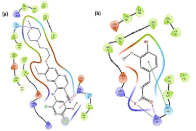Comprehensive Exploration of Ferulic Acid from Corn Leaves: Extraction, Structural Characterisation, HPLC Quantification, and Anti-inflammatory Evaluation through In Silico Docking, Molecular Dynamics Simulation, and In Vitro Studies
Main Article Content
Abstract
Ferulic acid, a phenolic compound with notable anti-inflammatory and antioxidant properties, has drawn significant interest for its therapeutic potential. Maize leaves, an abundant agricultural byproduct, are a sustainable source of ferulic acid, though efficient extraction and characterisation methods remain underdeveloped. This study presents an optimised protocol for isolating and characterising ferulic acid from maize leaves while evaluating its anti-inflammatory potential. The extraction process utilised aqueous methanol treatment to remove secondary metabolites, followed by alkali hydrolysis for ferulic acid isolation. The compound was purified via column chromatography, with temperature optimisation enhancing yield. Structural characterization was conducted using TLC, FT-IR, 1H, and 13C NMR. Quantitative analysis was achieved using a validated HPLC method. In silico docking studies demonstrated strong binding interactions between ferulic acid and p38 MAPK, a key inflammation-related protein, with docking scores comparable to those of bosutinib, a known anti-inflammatory agent. Additionally, in vitro, bovine serum albumin (BSA) denaturation assays revealed a dose-dependent inhibition of BSA denaturation, with significant effects observed at 100 µM. This study establishes an efficient method for extracting and characterising ferulic acid from maize leaves and highlights its promising anti-inflammatory properties, suggesting its potential for therapeutic applications.
Downloads
Article Details

This work is licensed under a Creative Commons Attribution-NonCommercial-NoDerivatives 4.0 International License.
How to Cite
References
Beladjal H, Bouhadi D, Belkhodja H. HPLC-DAD analysis and antioxidant potential of Ferula assafoetida resin ethanol extract. Trop J Nat Prod Res. 2024;8(4):6906-6910. Available from: https://doi.org/10.26538/tjnpr/v8i4.22
Hussain M, Qamar A, Saeed F, Rasheed R, Niaz B, Afzaal M, Ahmed A, Ahmad A, Anjum F. Biochemical properties of maize bran with special reference to different phenolic acids. Int J Food Prop. 2021;24(1):1468–1478. https://doi.org/10.1080/10942912.2021.1973026
Singh G, Jose S, Kaur D, Soun B. Extraction and characterisation of corn leaf fiber. J Nat Fibers.2020;19(5):1581–1591. https://doi.org/10.1080/15440478.2020.1787914
Matin M, Uddin S, Rohman M, Maniruzzaman M, Azad A, Banik B. Genetic variability and path analysis studies in hybrid Maize (Zea mays L.). Am J Plant Sci. 2017;8:3101–109. https://doi.org/10.4236/ajps.2017.812209
Zhang Z, Yang P, Zhao J. Ferulic acid mediates prebiotic responses of cereal-derived arabinoxylans on host health. Anim Nutr. 2021;9:31–38. https://doi.org/10.1016/j.aninu.2021.08.004.
Raj N, Siingh D. A critical appraisal on ferulic acid: the biological profile, biopharmaceutical challenges, and nanoformulations. Health Sci Rev. 2022;5:100063. https://doi.org/10.1016/j.hsr.2022.100063
Stompor-Gorący M, Machaczka M. Recent advances in biological activity, new formulations and prodrugs of ferulic acid. Int J Mol Sci. 2021;22(23):12889. https://doi.org/10.3390/ijms222312889.
Kumar N, Pruthi V. Potential applications of ferulic acid from natural sources. Biotechnol Rep (Amst). 2014;4:86–93. https://doi.org/10.1016/j.btre.2014.09.002.
Ye L, Hu P, Feng LP, Huang LL, Wang Y, Yan X, Xiong J, Xia HL. Protective effects of ferulic acid on metabolic syndrome: A comprehensive review. Molecules. 2022;28(1):281. https://doi.org/10.3390/molecules28010281.
Zhai Y, Wang T, Fu Y, Yu T, Ding Y, Nie H. Ferulic acid: A review of pharmacology, toxicology, and therapeutic effects on pulmonary diseases. Int J Mol Sci. 2023;24(9):8011.: https://doi.org/10.3390/ijms24098011.
Liu Y, Shi L, Qiu W, Shi Y. Ferulic acid exhibits anti-inflammatory effects by inducing autophagy and blocking NLRP3 inflammasome activation. Mol Cell Toxicol. 2022;18(4):509–519. https://doi.org/10.1007/s13273-021-00219-5.
Adeyi E, Oluwatobi S, Ajayi B, Adewale J, Taiwo A, Daniel O, Ebunoluwa O, Ebenezer S, Iyabode M. The anti-inflammatory effect of ferulic acid is via the modulation of NFκB-TNF-α-IL-6 and STAT1-PIAS1 signaling pathways in 2-methoxyethanol-induced testicular inflammation in rats. Phytomedicine Plus. 2023;3:100464. https://doi.org/10.1016/j.phyplu.2023.100464.
Mir SM, Ravuri HG, Pradhan RK, Narra S, Kumar JM, Kuncha M, Kanjilal S, Sistla R. Ferulic acid protects lipopolysaccharide-induced acute kidney injury by suppressing inflammatory events and upregulating antioxidant defenses in Balb/c mice. Biomed Pharmacother. 2018;100:304-315. https://doi: 10.1016/j.biopha.2018.01.169.
Aarabi A, Honarvar M, Mizani M, Faghihian H, Gerami A. Extraction and purification of ferulic acid as an antioxidant from sugar beet pulp by alkaline hydrolysis. Ital J Food Sci. 2016;28(3):362-375. doi: 10.14674/1120-1770/ijfs.v143.
Bajpai VK, Majumder R, Park J. Isolation and purification of plant secondary metabolites using column-chromatographic technique. Bangladesh J Pharmacol. 2016;11(4):844. doi: 10.3329/bjp.v11i4.28185.
Kowalska T, Kaczmarski K, Prus W. Theory and mechanism of thin-layer chromatography. In: Sherma J, Fried B, editors. Handbook of Thin-Layer Chromatography. 3rd ed. Revised and Expanded. New York: Marcel Dekker; 2003. p. 47-80.
Snyder LR, Kirkland JJ, Glajch JL. Practical HPLC Method Development. 1st ed. New York: John Wiley and Sons; 1997. doi:10.1002/9781118592014.
Zhao X, Wang M, Zhang Y, Zhang Y, Tang H, Yue H, Zhang L, Song D. Macrophages in the inflammatory response to endotoxic shock. Immun Inflamm Dis. 2024;12(10):e70027. doi: 10.1002/iid3.70027.
Yang Y, Kim SC, Yu T, Yi YS, Rhee MH, Sung GH, Yoo BC, Cho JY. Functional roles of p38 mitogen-activated protein kinase in macrophage-mediated inflammatory responses. Mediators Inflamm. 2014;2014:352371. doi: 10.1155/2014/352371.
Kim C, Sano Y, Todorova K, Carlson BA, Arpa L, Celada A, Lawrence T, Otsu K, Brissette JL, Arthur JS, Park JM. The kinase p38 alpha serves cell type-specific inflammatory functions in skin injury and coordinates pro- and anti-inflammatory gene expression. Nat Immunol. 2008;9(9):1019-27. doi: 10.1038/ni.1640.
Alves E, Bannimath G, Prabhakaran P, Parameswaran S, Awasthi A. Targeting breast cancer: Unveiling FN3K enzyme inhibitors via structure-based virtual screening and molecular dynamic simulation. IJNRD - International Journal of Novel Research and Development. 2024;9(6). https://ijnrd.org/papers/IJNRD2406239.pdf
M A, I MA, Ramalingam K, S R. Evaluation of the Anti-inflammatory, Antimicrobial, Antioxidant, and Cytotoxic Effects of Chitosan Thiocolchicoside-Lauric Acid Nanogel. Cureus. 2023;15(9):e46003. doi: 10.7759/cureus.46003.
Mans DRA, Friperson P, Djotaroeno M, Sewberath Misser V, Pawirodihardjo J. In vitro anti-inflammatory and antioxidant activities and phytochemical content of the fresh stem juice from Montrichardia arborescens Schott (Araceae). Pharmacogn J. 2022;14:296-304. doi: 10.5530/pj.2022.14.99.


